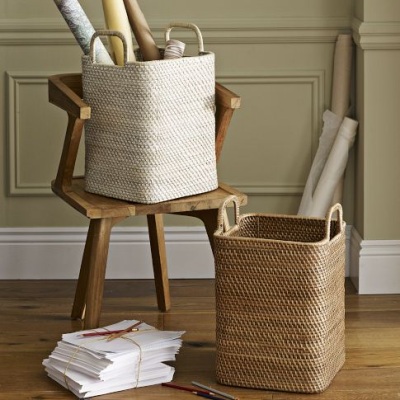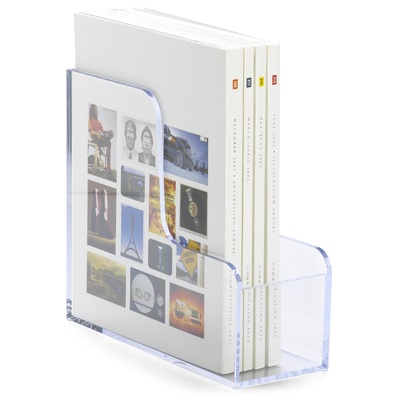 Maybe it’s the new year that’s inspired me to get organized. Or maybe it’s because I’ve been working on a client project, designing a built-in mail and message center. Designed to go into a niche in the kitchen, the unit will provide a touch-down spot to house mail, supplies, homework, chargers and other of the family’s necessities. It’s replete with paper sorter, supply drawers, dry-erase board, recycling bin pull-outs and a charging station. (Does that sound cool or what? I know, I want one too!) In any case, I have started the new year in an effort to streamline, organize and conquer the paper clutter monster once and for all. And while a built-in unit is not going to be happening in my house anytime soon, I’ve found there are lots of stylish organizers out there that work great and look great too.
Maybe it’s the new year that’s inspired me to get organized. Or maybe it’s because I’ve been working on a client project, designing a built-in mail and message center. Designed to go into a niche in the kitchen, the unit will provide a touch-down spot to house mail, supplies, homework, chargers and other of the family’s necessities. It’s replete with paper sorter, supply drawers, dry-erase board, recycling bin pull-outs and a charging station. (Does that sound cool or what? I know, I want one too!) In any case, I have started the new year in an effort to streamline, organize and conquer the paper clutter monster once and for all. And while a built-in unit is not going to be happening in my house anytime soon, I’ve found there are lots of stylish organizers out there that work great and look great too.
In my home there are typically four kinds of paper-related items that enter the house and have to be dealt with in some form or fashion, so my approach varies depending on the item. Here’s the system I came up with for dealing with each, and a few super stylish options I found for corralling the clutter:
(1) Items that require little or no action: junk mail, catalogs, flyers, school papers
Junk mail and the endless loose leaf papers that come home in my son’s backpack* are the worst offenders. These go directly in the recycling basket located conveniently beside the front door. I like an open bin with handles for this purpose, which makes it easy to toss stuff in, then carry the whole thing out to the recycling bin once it’s full. *For the record, we do save (and even sometimes frame) the occasional art class masterpiece, and there is a stack of plastic drawers in my son’s room where he can keep his favorite projects.

This colorful, handwoven fair-trade basket from Ghana will add a global accent to your entry. Available at French Connections; photo via french-nc.com.

I love the western-chic style of this cowhide basket. Available at Pfeifer Studo; image via pfieferstudio.com.

These wicker baskets from West Elm have a nice clean look and generous proportions. Photo via westelm.com.
(2) Items needing immediate attention: bills to pay, forms to be returned, checks to deposit
I’ve found that the key with items requiring some sort of time-sensitive response is to keep them front, center and very, very visible. Maybe other people have the discipline and excellent memory required to retrieve bills out of a file drawer but I do not. For me it’s out of sight, out of mind. So, I prefer containers that provide good visibility to the contents and which are not so big that the paper can pile up.

I see these vntage toast racks at flea markets all the time, and I’ve often thought they’d make great letter sorters. Photo via etsy.com.

This acrylic organizer from Container Store is the one I use on my desk. I love that it perfectly fits standard size envelopes, checks, bills and related essentials such as stamps. Photo via containerstore.com.

These bright in-boxes from Poppin are hard to ignore! They come in a rainbow of other colors and are stackable but not too deep, which is key to preventing paper from piling up. Photo via poppin.com.
(3) Information related to current and ongoing projects: e.g. applications, research materials, home improvement projects
I like to organize each project in a folder, file, or compartment of some kind so that materials all stay together. Again, I’ve found that keeping these files close at hand (on top of my desk or within arm’s reach) is key to ensure I remember to do whatever it is I’m supposed to be doing with them.

This banded project file from Semikolon is great for keeping project information in one place. Available at See Jane Work; photo via seejanework.com.

This portable file tote is perfect if you’re frequently on the go. Available from The Office Stylist; photo via sortingwithstyle.com.

The Kvissle wall magazine rack from Ikea has a nice clean design, with 5 slots just big enough to hold about one project each. I hung this in my office to keep current projects close at hand. Photo via ikeausa.com.

These clear acrylic filing boxes from Container Store are equally great for storing current magazines and project files. Again, the clear design makes it hard to forget what’s in there. Photo via containerstore.com.
(4) Information that needs to be saved but will be accessed rarely: tax documents, legal documents, records, warranties, etc.
This is where your handy file cabinet comes in! Or maybe a safe deposit box depending on what we’re talking about. These items do not have to be in sight, just able to be located and retrieved easily. I simply stash these papers in a labeled file folder, then into the file cabinet or file box they go.

This convenient rolling file cabinet from CB2 is offered in fun, very current colors like the mint shown here. Photo via cb2.com.

How exquisite are these hand-made wood file boxes with dovetail joinery by Dutch Crafters? Plus they’re stackable and have convenient carry handle. Image via dutchcrafters.com.

This super fun and mod-styled file cabinet from Poppin come in a range of their signature rainbow colors. Great for a teenager’s room! Photo via poppin.com.
Though we still do get the occasional pile-up, so far my storage systems are working pretty well at keeping the paper clutter monster at bay. Now, if I could only figure out how to get my five-year old to put his toys away… a blog post for another day!
——
Tamara Leicester is a licensed interior designer and owner of Tamara Heather Interior Design, LLC. She designs casually elegant interiors with an artistic sensibility, often drawing upon the talent of local artists and craftspeople in her work. Dreaming about updating your space? Learn more at tamaraheatherinteriors.com.
